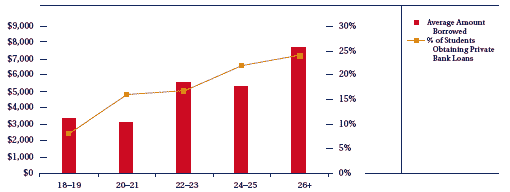

Source: Canadian Millennium Scholarship Foundation’s 2001-02 Student Income-Expenditure Survey as cited in Junor and Usher (2004).
In addition to loans, the Government of Canada offers Canada Study Grants (CSG) that top-up or replace student loans for high-need students. There are two components to these grants. The first component, Canada Study Grants for High-Need Part-Time, provides non-repayable grants to part-time students who can demonstrate financial need. For a single independent student, the maximum family income threshold is $14,100. For students from a family of two the threshold is $23,300. The grants are up to $1,200 and count as taxable income. In 2002-03, the number of students receiving the CSG for High-need Part-time Students exceeded the number of students receiving part-time student Canada Student Loans (Junor and Usher, 2004). The second component, Canada Study Grants for Students with Dependents, provides students with dependents with grants of up to $3,120 (for full-time students) or $1,920 (for part-time students) per year (HRSDC, 2004). In 2002-03, just over 55,000 CSGs were distributed, with about 80 percent issued to students with dependents, and the rest issued to high-need part-time students.
The federal government also provides some funds to EI eligible individuals who require skills upgrading to secure employment. However because the program targets short-term training, it primarily benefit individuals taking private technical/vocational programs or skill seminars run by independent contractors. Relatively little EI funding goes to ‘students’ who are pursuing postsecondary diplomas or degrees (Junor and Usher, 2004). Indeed the 2004 Canadian College Survey found that while almost 10 percent of respondents indicated using the Employment Insurance funds to support their education, the majority of these respondents were enrolled in short term access and upgrading programs (Prairie Research Associates, 2005).